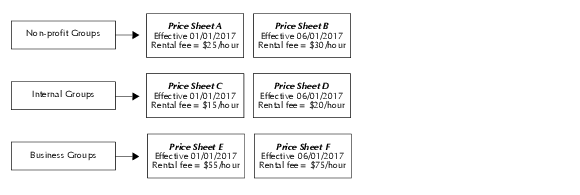Rate schedules
Definition
A rate schedule is a collection of pricing rules for a set of related items. Each of the included items (locations, resources, requirements, and event types) is priced according to the same rules.
Rate schedule types
A rate schedule can be one of these four types:
• Event Type where pricing is based on event type
• Location where pricing is based on the locations assigned
• Resource where pricing is based on the resources assigned
• Requirement where pricing is based on event requirements
Rate schedule components
Rate schedules have three components:
• Price sheets
• Tax schedules (if applicable)
• Billable items
Price sheets
One or more price sheets can be defined for each rate group. Each price sheet has an effective date. Rate schedules can have many price sheets for a single rate group, each with a different effective date.
In this example, the rate schedule for a group of large rooms includes price sheets for three different rate groups. Each rate group has a price sheet effective from January 1, 2017 and a price sheet effective from June 1, 2017.
Rate Schedule: Large (50+) Room Rental Fees

Price sheets are defined using formulas similar to those used in many spreadsheet applications. See
“Pricing Formula Examples and Variables” for details.
Applying tax schedules to rate schedules
You can apply one or more tax schedules to each rate schedule. In this example, a service tax of 9% is applied to the rate schedule and the tax rate changes on a future date.
Rate Schedule: Large (50+) Room Rental Fees

Billable items
For each rate schedule, you indicate to which billable items the price sheets and tax schedule apply. In this example, we’ve identified the four rooms to which the Large (50+) Room Rental Fees rate schedule applies.

Rate Schedule: Large (50+) Room Rental Fees
Rate schedule types and billable items
The example above is a location type rate schedule, so its billable items are locations. Likewise, the billable items for event type rate schedules are event types; for requirements type rate schedules, requirements; for resource type rate schedules, resources.
Billable item pricing possibilities
There are many ways to price a billable item with 25Live Pricing:
• A flat fee (regardless of time and/or quantity)
• A per hour charge with or without a minimum or maximum
• Based on the time of day and/or day of the week the item is used
• Based on the head count of the event
• Based on the required quantity of the item
• Combinations of the above, and more
| Billable item pricing assumptions 25Live Pricing assumes the following: • An event type is priced on the basis of each event occurrence. • A location is priced on the basis of each event occurrence to which it has been assigned. • A resource is priced on the basis of each event occurrence to which it has been assigned. • A requirement is priced irrespective of event occurrence, in effect a flat fee, regardless of how many occurrences the event has. |
Purpose and benefits of rate schedules
Rate schedules provide a great deal of flexibility in how you price items, and they ensure campus-wide consistency in billing.
• You can charge different prices to different types of groups.
• You can apply taxes to certain types of items.
• You can set up many prices at once, each with a different effective date.
• Schedulers don’t have to turn to another source to look up pricing practices and rules.
The pricing date specified for an event determines which rate schedules are available for selection for each item being invoiced. A single rate schedule is selected for each item with pricing attached (the default rate schedule is the one with the latest date falling before or on the event pricing date).




 Rate Schedule: Large (50+) Room Rental Fees
Rate Schedule: Large (50+) Room Rental Fees